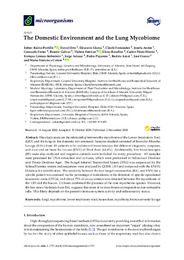Título :
The Domestic Environment and the Lung Mycobiome |
Autor :
Rubio-Portillo, Esther 
Orts, David 
Llorca, Eleuterio
Fernández Aracil, Cleofé 
Anton, Josefa 
Ferrer, Consuelo
Gálvez, Beatriz
Esteban Ronda, Violeta 
Revelles, Elena
Pérez-Martín, Carlos 
Gómez Imbernón, Enrique 
Adsuar, Jorge
Piqueras, Pedro
Amat, Beatriz
Franco, José
Colom Valiente, María Francisca  |
Editor :
MDPI |
Departamento:
Departamentos de la UMH::Producción Vegetal y Microbiología |
Fecha de publicación:
2020 |
URI :
https://hdl.handle.net/11000/37779 |
Resumen :
This study analyzes the relationship between the mycobiome of the Lower Respiratory Tract
(LRT) and the fungi in the domestic environment. Samples studied consisted of Broncho-Alveolar
Lavage (BAL) from 45 patients who underwent bronchoscopy for di erent diagnostic purposes,
and dust and air from the houses (ENV) of 20 of them (44.4%). Additionally, five bronchoscopes
(BS) were also analyzed and negative controls were included for every procedure. All samples
were processed for DNA extraction and cultures, which were performed in Sabouraud Dextrose
and Potato Dextrose Agar. The fungal Internal Transcribed Spacer (ITS2) was sequenced by the
Solexa/Illumina system and sequences were analyzed by QIIME 1.8.0 and compared with the UNITE
Database for identification. The similarity between the two fungal communities (BAL and ENV) for a
specific patient was assessed via the percentage of coincidence in the detection of specific operational
taxonomic units (OTUs), and about 75% of co-occurrence was detected between the mycobiome of
the LRT and the houses. Cultures confirmed the presence of the core mycobiome species. However,
the low rate of isolation from BAL suggests that most of its mycobiome corresponds to non-culturable
cells. This likely depends on the patient’s immune system activity and inflammatory status.
|
Palabras clave/Materias:
fungi
mycobiome
lower respiratory tract
house dust
mycobiota
bronco-alveolar lavage |
Tipo de documento :
info:eu-repo/semantics/article |
Derechos de acceso:
info:eu-repo/semantics/openAccess
Attribution-NonCommercial-NoDerivatives 4.0 Internacional |
DOI :
https://doi.org/10.3390/microorganisms8111717 |
Publicado en:
Microorganisms. 2020 Nov 2;8(11):1717 |
Aparece en las colecciones:
Artículos - Producción vegetal y microbiología
|
 La licencia se describe como: Atribución-NonComercial-NoDerivada 4.0 Internacional.
La licencia se describe como: Atribución-NonComercial-NoDerivada 4.0 Internacional.
.png)
